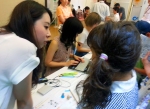(English below) ほとんどの音声学の教科書は読みにくいと思いませんか?大体カタカナの用語が多くてドライな感じでしょう?最初に音声学の授業を受けた時に本当にそう思いました。日本の授業だったのに、英語の教科書を使って、学生が皆翻訳しながら学ばないといかなかった。そして例があっても、英語の例なので日本人のクラスメートにはとてもわかりにくい気がしました。 慶応の川原繁人大先生の新しい入門書、「音とことばのふしぎな世界:メイド声から英語の達人まで」、は違います。わかりやすい日本語で書いてありますし、流れはほとんどの教科書と違います。典型的な音声学の教科書は発音記号から、調音、音響、知覚まで分野に分けて説明しますが、この「音とことばのふしぎな世界」のチャプターはある謎から初めて、音声学を説明しながら推理小説みたいにミステリーを解けます。例えば、メイドさんの声は普通の声とどういう風に違うのか、[r]と[l]の違いは何のか、そう言う興味深い謎から発展します。外国人の僕でさえ原稿を読んで、わかりやすいと思いましたので入門書として抜群と思います。そして僕が描いたフィギュアもちょっと入ってます! Have you ever looked at a phonetics textbook and thought, “Geez, this is really dry and boring”? I sure have. I remember when I first started learning phonetics here in Japan, we had this very standard,…
Blog Archives
Our poster presentation for ICPhS in Glasgow: or, what the heck is Jeff researching?
This is the poster we’re presenting this week in Glasgow, designed by yours truly. In quick, layman’s terms: We had people say the phrase ‘Pam said bat that fat cat at that mat’, with emphasis placed on different words. We…
Teaching kids at the National Museum of Nature and Science

Last weekend, our lab gave a demo at the National Museum of Nature and Science here in Tokyo. They were running an event called Science Square, where kids can come and meet scientists and engineers and participate in hands-on activities.…
Posted in Phonetics and Phonology
Do you see what I’m saying? Lip-reading in a second language
Studies on speech perception have tended to focus on sound as the only cue. In speech sciences, we usually talk about phonemes in terms of sounds, and we think of the ‘speech signal’ as being acoustic, mainly. But sound isn’t…
Posted in Paper Summaries, Phonetics and Phonology
331st Meeting of the Phonetic Society of Japan
Today I took the very long, arduous 5 minute walk to Waseda campus, and heard five talks from phoneticists in and around Tokyo. I used to feel pretty nervous about going to these kinds of meetings, but now that I…
Posted in Phonetics and Phonology
The Speech Learning Model
I promised a few weeks ago that I’d write about Jim Flege’s Speech Learning Model next. Dutifully, I read his chapter in Winifred Strange’s Speech Perception and Linguistic Experience, made notes in the margin, carried the paper around with me…
Posted in Phonetics and Phonology
The Perceptual Assimilation Model
Recently I started a doctoral course at Sophia, and so far it’s been really great. I’m doing everything that I want to be doing, the other students in the lab are wonderful people, and Arai-sensei has been good at giving…
Posted in Paper Summaries, Phonetics and Phonology
C/D model website, and my MA defense
Two quick pieces of news: Yesterday I started a site with Donna Erickson and Shigeto Kawahara to promote the C/D model. If you’re not familiar, the C/D model is short for “converter/distributor model”. It’s a way of describing how phonology…
New Experiment: Rapid Prosodic Transcription
Hot off the presses! Here’s a new program I made for one of Donna Erickson’s experiments. It’s all about testing where people hear stress and phrase breaks in speech. If you’re in one of Donna’s classes, and this is your…
Understanding speech analysis software
In this post, I’m going to explain all the different parts of a Speech Analysis window in WaveSurfer. Going from the top, there’s a waveform (波形 in Japanese), and that shows the wave of sound in the air that the…